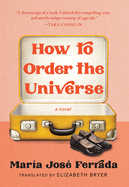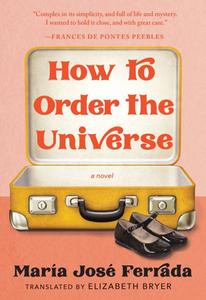
 María José Ferrada's How to Order the Universe offers an imaginative view of Pinochet-era Chile through a child's eyes, as she assists her father in his work as a traveling salesman of Kramp brand hardware items. The world appears complex, fascinating and a little magical to M, the narrator. Elizabeth Bryer's whimsical translation from the Spanish feels appropriate to M's exceptional perspective.
María José Ferrada's How to Order the Universe offers an imaginative view of Pinochet-era Chile through a child's eyes, as she assists her father in his work as a traveling salesman of Kramp brand hardware items. The world appears complex, fascinating and a little magical to M, the narrator. Elizabeth Bryer's whimsical translation from the Spanish feels appropriate to M's exceptional perspective.
Ferrada's playful, poignant novel opens with the story of a young man named D, whose "first sales attempt happened the same day a man took a step on the moon." He meets a beautiful woman. They marry and have a child, M, and so the narrator enters her own story. She begins accompanying D on his sales calls when she is seven. M's school attendance is sporadic; her work as D's assistant is important to both of them, and M's mother is a bit detached. Father and daughter are close, in their dreamy interactions with each other and with a small community of salesmen and shopkeepers. She is treated as a small adult: "in recognition, I think, of the fact that I had grasped the complexities of human beings at such a young age, D showed me how to blow smoke rings. Small rings that crossed the city, expanding and dissolving in the distance."
M's narrative voice is solemn, serious. She is a little obsessed with categories and classification. D's understanding of the world, and therefore M's as well, involves hammer, nails, the moon and stars. "Every person tries to explain the inner workings of things with whatever is at hand. I, at seven years of age, had reached out my hand, and had grasped a Kramp catalogue." She studies the organization of items for sale in shops: "I thought that discovering the sequence would bring me a little closer to comprehending the classifications used by the Great Carpenter to order the universe." M is a precocious philosopher, but also a child, for whom certain realities eventually come as a surprise. When the family circumstances unexpectedly change, "There were two possibilities: A. Precariousness had always been with us, and I'd never noticed. B. Something had changed. Whichever it was, my childhood memories fractured: crack."
How to Order the Universe is fanciful, sweet and moving, as M gradually registers and questions the changing world she inhabits, wrestling with violence, absence, the ability to make one's own luck "with well-shined shoes and the right outfit." Much of this evolution is filtered through her irrevocably changed relationship with D. "We had been deeply united by a catalogue of hardware store products: nails, hammers, door viewers, screws. But that catalogue no longer existed." This is a beautifully translated, thought-provoking novel of profound themes and childlike wonder. --Julia Kastner, librarian and blogger at pagesofjulia
Shelf Talker: Through a child's clever but innocent point of view, this inventive debut novel considers family, hope and the harsher realities of 1980s Chile.

